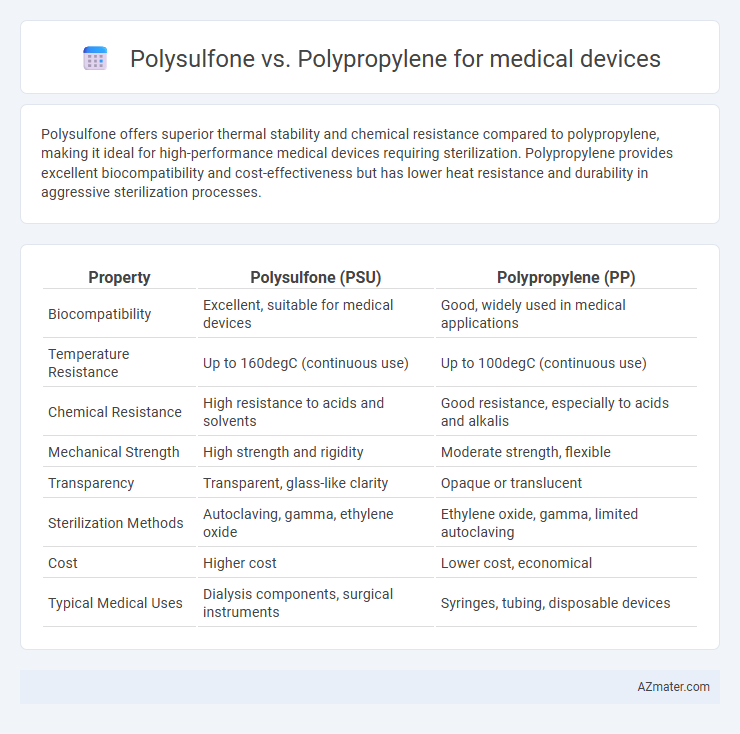Polysulfone offers superior thermal stability and chemical resistance compared to polypropylene, making it ideal for high-performance medical devices requiring sterilization. Polypropylene provides excellent biocompatibility and cost-effectiveness but has lower heat resistance and durability in aggressive sterilization processes.
Table of Comparison
| Property | Polysulfone (PSU) | Polypropylene (PP) |
|---|---|---|
| Biocompatibility | Excellent, suitable for medical devices | Good, widely used in medical applications |
| Temperature Resistance | Up to 160degC (continuous use) | Up to 100degC (continuous use) |
| Chemical Resistance | High resistance to acids and solvents | Good resistance, especially to acids and alkalis |
| Mechanical Strength | High strength and rigidity | Moderate strength, flexible |
| Transparency | Transparent, glass-like clarity | Opaque or translucent |
| Sterilization Methods | Autoclaving, gamma, ethylene oxide | Ethylene oxide, gamma, limited autoclaving |
| Cost | Higher cost | Lower cost, economical |
| Typical Medical Uses | Dialysis components, surgical instruments | Syringes, tubing, disposable devices |
Introduction to Polysulfone and Polypropylene
Polysulfone (PSU) is a high-performance polymer known for its excellent heat resistance, chemical stability, and biocompatibility, making it ideal for medical device components requiring sterilization and durability. Polypropylene (PP) is a versatile thermoplastic widely used in medical devices due to its toughness, chemical resistance, and cost-effectiveness, especially in disposable applications. Both materials offer distinct advantages, with polysulfone excelling in demanding environments and polypropylene favored for lightweight, single-use products.
Chemical Structure and Properties Comparison
Polysulfone features an aromatic backbone with sulfone groups, granting exceptional thermal stability, chemical resistance, and mechanical strength ideal for medical devices requiring sterilization and durability. Polypropylene, a semi-crystalline polyolefin composed of repeating propylene units, offers excellent chemical resistance and low density but has lower thermal stability and mechanical strength compared to polysulfone. The rigid, polar sulfone groups in polysulfone enhance its dimensional stability and resistance to hydrolysis, while polypropylene's non-polar hydrocarbon structure provides good biocompatibility and flexibility but limits its usage in high-temperature or aggressive chemical environments.
Mechanical Strength and Durability
Polysulfone exhibits superior mechanical strength and durability compared to polypropylene, making it ideal for demanding medical device applications requiring high performance under stress. Its excellent resistance to hydrolysis and thermal stability ensures long-term reliability in sterilization cycles. Polypropylene, while cost-effective and chemically resistant, offers lower mechanical strength and may degrade faster under repeated sterilization or mechanical loading conditions.
Biocompatibility and Safety Profiles
Polysulfone exhibits superior biocompatibility and thermal stability compared to polypropylene, making it ideal for medical devices requiring repeated sterilization and long-term use. Polypropylene offers excellent chemical resistance and lower cost but may release additives or degrade under harsh sterilization, potentially impacting safety. The choice between polysulfone and polypropylene hinges on the specific medical application's demands for biocompatibility, sterilization method compatibility, and regulatory compliance.
Sterilization Compatibility
Polysulfone exhibits superior sterilization compatibility in medical devices due to its high resistance to steam autoclaving, gamma radiation, and ethylene oxide sterilization methods, maintaining structural integrity and clarity. Polypropylene is also sterilizable but is more susceptible to deformation under high-temperature steam autoclaving and may degrade with repeated gamma sterilization cycles. Selecting polysulfone ensures enhanced durability and reliability in sterilization processes critical for maintaining medical device performance and patient safety.
Thermal Stability and Resistance
Polysulfone exhibits superior thermal stability with a glass transition temperature around 185degC, making it ideal for high-temperature sterilization processes in medical devices. Polypropylene, while less thermally stable with a melting point near 160degC, offers excellent chemical resistance but can deform under extended heat exposure. The enhanced heat resistance and durability of polysulfone ensure reliable performance in medical applications requiring repeated autoclaving, whereas polypropylene suits disposable or low-heat environments.
Applications in Medical Devices
Polysulfone exhibits exceptional thermal stability, chemical resistance, and biocompatibility, making it ideal for applications such as sterilizable medical tubing, surgical instrument handles, and dialyzers. Polypropylene's lightweight, low cost, and chemical resistance properties suit disposable medical devices, syringe components, and packaging applications. Both materials are critical in medical devices, with polysulfone favored for reusable, high-performance parts and polypropylene widely used in single-use products.
Cost-Effectiveness Analysis
Polysulfone offers superior thermal and chemical resistance compared to polypropylene, making it ideal for sterilizable medical devices but at a higher material cost. Polypropylene provides excellent cost-efficiency due to its lower price and ease of processing, suitable for disposable or low-stress applications. When conducting cost-effectiveness analysis, the choice depends on balancing the upfront expense of polysulfone against the potential for device reuse and longevity, whereas polypropylene's low cost favors single-use medical products.
Regulatory Approvals and Industry Standards
Polysulfone (PSU) and polypropylene (PP) differ significantly in regulatory approvals for medical devices, with polysulfone often meeting stringent U.S. FDA and ISO 10993 biocompatibility standards due to its high thermal stability and chemical resistance. Polypropylene, widely accepted for single-use medical applications, complies with FDA 21 CFR 177.1520 regulations and USP Class VI standards but generally lacks the high-temperature resilience required for sterilization cycles like autoclaving, which polysulfone withstands. Industry standards favor polysulfone in reusable medical devices requiring repeated sterilization, whereas polypropylene is preferred for disposables, reflecting their distinct performance and regulatory profiles.
Conclusion: Selecting the Best Material for Medical Devices
Polysulfone offers superior thermal stability, chemical resistance, and biocompatibility, making it ideal for high-performance medical devices requiring sterilization and durability. Polypropylene provides cost-effective, lightweight options with good chemical resistance but limited temperature tolerance and mechanical strength compared to polysulfone. Choosing the best material depends on the specific application requirements, balancing performance, sterilization methods, and budget constraints in medical device manufacturing.

Infographic: Polysulfone vs Polypropylene for Medical device
 azmater.com
azmater.com